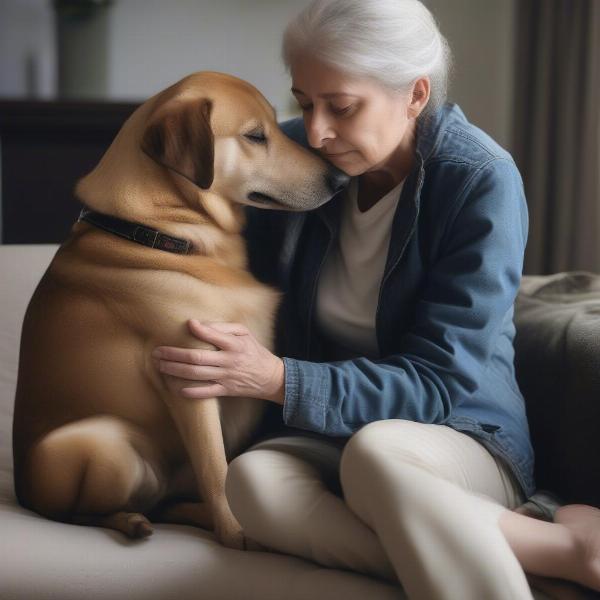Nerve sheath tumors (NSTs) in dogs can be a worrying diagnosis for any pet owner. These tumors arise from the cells that surround and protect the nerves, and can occur anywhere in the body. Understanding the different types, symptoms, diagnosis, and treatment options for nerve sheath tumors is crucial for providing the best possible care for your canine companion. This guide will explore everything you need to know about nerve sheath tumors in dogs.
Types and Symptoms of Nerve Sheath Tumors in Dogs
Several types of NSTs can affect dogs, with the most common being schwannomas and neurofibromas. Schwannomas originate from Schwann cells, while neurofibromas arise from fibroblasts and other connective tissues within the nerve sheath. These tumors can be benign or malignant, although benign forms are more prevalent.
The symptoms of a nerve sheath tumor in dogs vary depending on the tumor’s location and size. Common signs include:
- Pain: Especially noticeable when the affected area is touched or moved.
- Lameness: If the tumor affects a limb.
- Weakness or paralysis: As the tumor presses on the nerve.
- Swelling or a lump: May be palpable under the skin.
- Changes in behavior: Such as increased irritability or aggression due to pain.
- Facial droop: dog facial droop can be a sign of a trigeminal nerve sheath tumor.
Diagnosing Nerve Sheath Tumors
Diagnosing a nerve sheath tumor involves a combination of physical examination, diagnostic imaging, and potentially biopsy. Your veterinarian will likely perform a thorough neurological examination to assess your dog’s reflexes and nerve function. Imaging techniques such as X-rays, CT scans, and MRI scans can help visualize the tumor and determine its location and size. A biopsy is often necessary to confirm the diagnosis and determine if the tumor is benign or malignant. how much is a dog ct scan
Treatment Options for Nerve Sheath Tumors in Dogs
Treatment options for NSTs vary depending on the tumor’s location, size, and whether it’s benign or malignant. Surgical removal is the preferred treatment for accessible tumors. Radiation therapy can be used to shrink the tumor and alleviate symptoms, particularly for tumors that cannot be surgically removed. In some cases, chemotherapy may be recommended, especially for malignant tumors.
Prognosis and Life Expectancy
The prognosis for dogs with nerve sheath tumors depends on various factors, including the tumor type, location, and stage. Benign tumors that are completely removed surgically often have a good prognosis. Malignant tumors, however, carry a less favorable prognosis and may require more aggressive treatment. trigeminal nerve sheath tumor dog life expectancy
Living with a Dog with a Nerve Sheath Tumor
Caring for a dog with a nerve sheath tumor can be challenging but rewarding. Providing pain management is crucial to ensure your dog’s comfort. Regular check-ups with your veterinarian are essential to monitor the tumor’s progression and adjust treatment as necessary. Creating a supportive and loving environment for your dog can significantly improve their quality of life.
 Owner Comforting Dog with Nerve Sheath Tumor
Owner Comforting Dog with Nerve Sheath Tumor
Conclusion
Nerve sheath tumors in dogs can be complex, but with proper diagnosis and treatment, many dogs can live happy and fulfilling lives. Early detection and intervention are key to improving the outcome. If you notice any unusual symptoms in your dog, consult your veterinarian promptly. nerve tumor in dogs spinal tumor dogs
FAQs
- Are nerve sheath tumors common in dogs? While not the most common type of tumor, NSTs can occur in dogs of any breed or age.
- Is surgery always an option for nerve sheath tumors? Surgery is the preferred treatment, but its feasibility depends on the tumor’s location and size.
- What is the recovery time after surgery for a nerve sheath tumor? Recovery time varies depending on the complexity of the surgery and the individual dog.
- Are there any alternative treatments for nerve sheath tumors in dogs? Palliative care options, such as pain management and physical therapy, can help improve a dog’s quality of life.
- How can I support my dog during treatment for a nerve sheath tumor? Providing a comfortable and loving environment, administering medications as prescribed, and attending regular veterinary appointments are crucial.
- What are the signs of recurrence after nerve sheath tumor removal? Recurrence symptoms can be similar to the initial signs and may include pain, swelling, or neurological deficits.
- Are certain breeds of dogs more prone to nerve sheath tumors? No specific breed is known to be significantly more predisposed to NSTs.
ILM Dog is a leading international website dedicated to providing expert advice and resources on dog care and wellbeing. From breed selection and health to training and nutrition, ILM Dog offers a comprehensive guide to responsible dog ownership. Our team of experienced writers and dog experts are passionate about helping you provide the best possible care for your furry friend. For personalized advice on dog health, training, or any other dog-related concerns, please reach out to our expert team via email at [email protected] or call us at +44 20-3965-8624. ILM Dog – Your trusted companion in dog care.